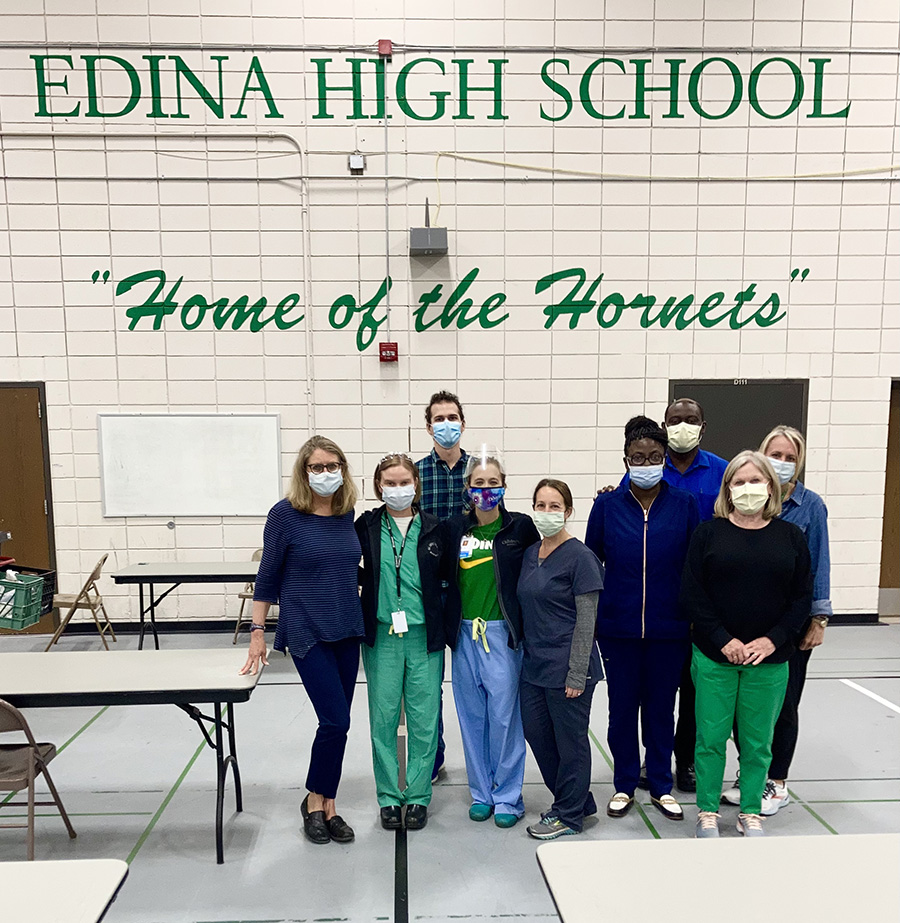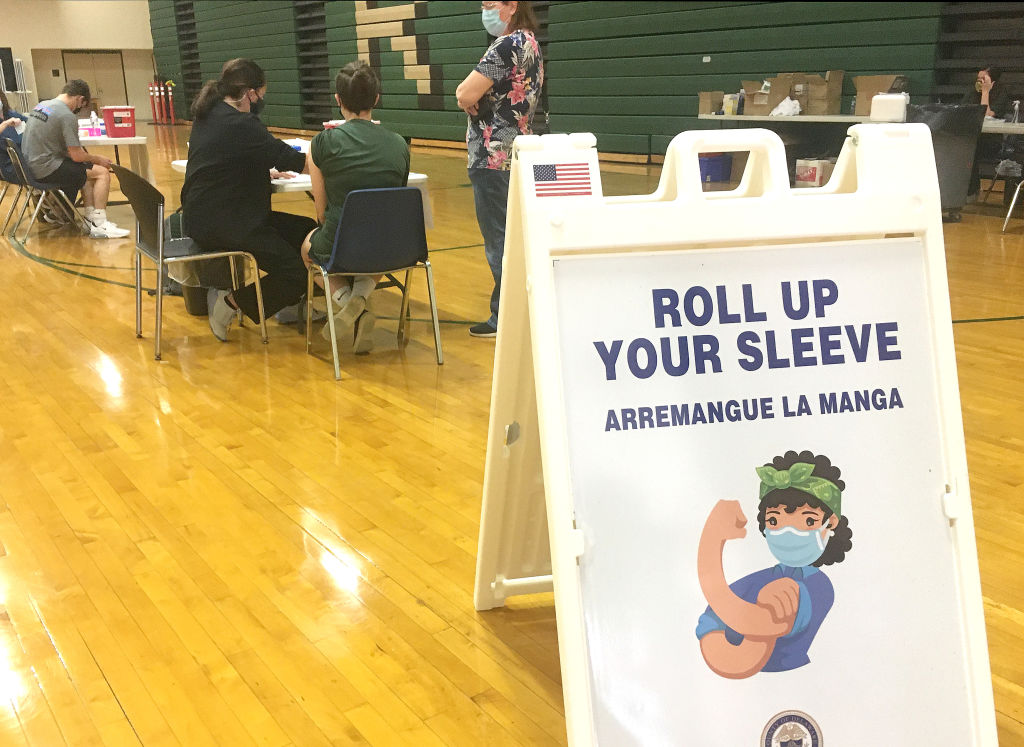As FDA Approves Shots for Youth 12 and Up, School Districts Get Creative Promoting Vaccine to Teens

Get essential education news and commentary delivered straight to your inbox. Sign up here for The 74’s daily newsletter.
Now that youth aged 12 to 15 have been cleared by the FDA for COVID-19 vaccines, what’s the best way to encourage those nearly 17 million newly eligible students to get vaccinated?
Letting them skip class to receive their shots doesn’t hurt.
That’s the winning approach East Hartford, Connecticut took in late April when the district organized a “student skip day” to help approximately 1,000 eligible students receive their first dose of the coronavirus vaccine. Throughout the day, school buses shuttled students to and from an outdoor clinic complete with staffers in costume as lime green yard goats — the mascot for Hartford’s minor league baseball team — dancing to tunes served up by a DJ over vibrating loudspeakers.
“I hate shots,” East Hartford senior Ayanna Lavinier told The 74, “but the music and everybody being there and it being quick — it was fun.” Getting to ditch class to get vaccinated “definitely” didn’t hurt, she added.
But while the hyped-up scene may be unique to East Hartford, the school-based vaccination strategy is being used by districts across the country.
Last week in Edina, Minnesota, an at-school vaccination clinic helped get 309 people vaccinated, organizers said. Students across Nassau County, New York, are working as “youth ambassadors” to encourage up to 1,500 students to get shots in return for community service hours. Over a dozen Baltimore County high schools are dispensing doses to eligible students over the course of May. And in Chicago, the teachers union is calling for “vaccine field trips” to bring youth to vaccine clinics.
Nassau County Executive Laura Curran hopes that the strategy of using youth ambassadors to answer peers’ questions will instill confidence in the COVID shots. The Long Island teens are trained to field all student questions, from vaccine side effects to worries over whether inoculation may impact future fertility. (It does not.)
“It’s one thing for … the grownups in your life to tell you to [get vaccinated],” Curran told The 74. “But when it’s your own peers, someone that you like, someone who’s a friend, someone that you trust, I think it has a certain resonance.”
Nicolette Carrion, who graduated high school in 2020 and now attends Georgetown University, is working with the county as a youth ambassador. Sometimes, she has to dispel blatant misinformation teens have heard online or through word of mouth, she said, and sometimes she needs to confront historical distrust of the medical establishment among Black peers.
In the face of understandable concern, Carrion, who is herself African American, reminds hesitant young people that “Black doctors help[ed] in the formulation of the vaccine.” But mostly, she gives them time to process.
“It’s very important to be empathetic and patient with people who have these worries,” Carrion told The 74.
Nassau schools are rewarding youth ambassadors with two full days of community service for their efforts. And students receiving the vaccine during the May 13-16 campaign are credited six hours per shot, which count toward annual school quotas students must fulfill.
“It really is community service when you think about it,” said Curran, the Nassau executive. “If we have good vaccination rates, that means businesses can function normally, society can function normally, we’re protecting our grandparents, school can open normally.”

Anne Griffiths, a pediatric pulmonologist at Children’s Minnesota who helped coordinate the Edina event, stressed that it’s key to bring vaccines directly to students.
“It was important to have it be available at the high school,” she told The 74. “[It] takes off some of the burden of transportation, time off work for parents and arranging for child care.”
Many students in the Minneapolis suburb, she said, were excited that full vaccination could allow them to bypass the district’s quarantine policy. With both doses, exposure to someone who tests COVID-19 positive would not mean a two-week hiatus from classes, sports and other extracurriculars, given the vaccinated student is not showing symptoms of the virus.
“This [shot] might increase the likelihood that they could stay involved in their classes and activities,” Griffiths explained.

After a study of 1,983 adolescents found the Pfizer-BioNTech vaccine to be 100 percent effective for youth aged 12 to 15 — with zero infections among the 1,005 inoculated young people and 16 cases among the 978 placebo recipients — the FDA expanded clearance to that age group on Monday.
Anticipating the federal agency’s move, Edina already has an event on the books this Friday to offer shots to students 12 and older, Griffiths said, provided that on Wednesday, the CDC also recommends the vaccine for use in 12 to 15 year olds — as most observers expect it will.
The district also has a follow-up vaccine clinic planned to deliver second doses to high schoolers who received shots last week.
Benjamin Linas, Boston University associate professor of epidemiology, hopes that schools across the country will follow Edina’s lead, becoming a community hub for COVID-19 shots and information.
He envisions schools stepping up to help with vaccinations as they did over a half century ago during the polio epidemic.
“We offered the vaccine in schools to children, and parents across America eagerly signed their kids up,” Linas observes. “There are … lessons to be had from the polio experience.”
Polling indicates that, currently, many parents may be hesitant to let their kids receive coronavirus shots. Only 3 in 10 said they would get their children vaccinated right away, while another 26 percent said they would wait and see how the vaccine was working, the New York Times reported last week.
School policies, however, may have the power to sway parental preferences. An additional 18 percent of parents said they would allow their children to receive shots if it were a school requirement.

The likelihood, however, of school vaccine mandates this fall remains low, says Dorit Reiss, professor of law at UC Hastings and a specialist in the legal intricacies of vaccination policy. That’s because such decisions are made at the state level, rather than on a school-by-school basis, and the process can be tricky.
Two key issues currently bar state-level action, Reiss told The 74. First, while coronavirus shots currently have emergency authorization status, the FDA has yet to issue full approval to vaccines. Pfizer and BioNTech submitted a joint application to the federal agency on May 7 for full clearance, but the process will likely take weeks, if not months.
“I think a lot of states will wait on full FDA approval to move on this,” said Reiss. “No state has ever added a vaccine that wasn’t recommended and I don’t think they will.”
But even if approval were granted quickly, another snag remains: Students under 12 years old won’t be eligible for coronavirus shots until early 2022, according to the latest estimates. That means that politicians hoping to add COVID vaccines to schools’ required lists would have to repeat the process for younger students soon after.
“I don’t think any politician would want to do it twice,” said the law professor. “When they do it, it will be when they can pass it for the whole K-12 [system].”
So in the meantime, schools looking to heighten COVID-19 protections next year may well focus on providing wide access to shots, rather than mandating them.
For students like Lavinier of East Hartford, who is scheduled to receive her second dose on May 17, getting vaccinated through her school’s event represented a key step toward a return to life as she once knew it.
“I just want life to go back to normal,” she said. “It’s been a really rough year.”
Once she’s fully vaccinated, the high school senior looks forward to hanging out with friends, going out to dinner with her family and having what will, fingers crossed, be a more regular first year at college in the fall.
Thinking about life post-second dose, “it feels good,” said Lavinier. “Clear future.”
Get stories like these delivered straight to your inbox. Sign up for The 74 Newsletter

;)
